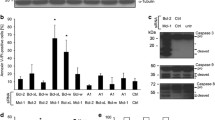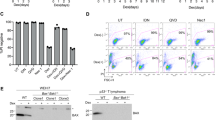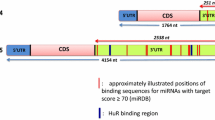Abstract
LUCA-15/RBM5 is a putative tumour suppressor. The gene encodes a number of alternative RNA splice variants with differing abilities to either enhance or suppress apoptosis, and it is likely that this ability to modulate apoptosis is central to the putative tumour suppressor activity of LUCA-15. This report demonstrates for the first time that expression from the LUCA-15 locus modulates apoptosis triggered by the death-inducing ligand TRAIL. Using Jurkat T lymphoblastic leukemia cells, LUCA-15 expression was shown to enhance not only TRAIL but TNF-α- and Fas-mediated apoptosis. LUCA-15, therefore, has the ability to lower the apoptotic threshold of multiple receptor-initiated death-inducing signals. Of note, sensitisation of the Jurkat cells to TRAIL was shown to depend on new protein synthesis, since no enhancement of apoptosis was observed when cells were exposed to both TRAIL and the protein synthesis inhibitor cycloheximide. This result suggests that LUCA-15 does not act independently to regulate apoptosis, but modulates a process that requires additional, newly synthesized protein. These results may explain the putative role of LUCA-15 as a tumour suppressor, suggesting that lack of functional LUCA-15 could provide the means by which malignant T cells escape receptor-initiated apoptotic signals.
Similar content being viewed by others
References
Oh JJ, West AR, Fishbein MC, Slamon DJ. A candidate tumor suppressor gene, H37, from the human lung cancer tumor suppressor locus 3p21.3. Cancer Res 2002; 62: 3207–3213.
Welling DB, Lasak JM, Akhmametyeva E, Ghaheri B, Chang LS. cDNA microarray analysis of vestibular schwannomas.Otol Neurotol 2002; 23: 736–748.
Edamatsu H, Kaziro Y, Itoh H. LUCA15, a putative tumour suppressor gene encoding an RNA-binding nuclear protein, is down-regulated in ras-transformed Rat-1 cells. Genes Cells 2000; 5: 849–858.
Mourtada-Maarabouni M, Sutherland LC, Williams GT. Candidate tumour suppressor LUCA-15 can regulate multiple apoptotic pathways. Apoptosis 2002; 7: 421–432.
Mourtada-Maarabouni M, Sutherland LC, Meredith JM, Williams GT. Simultaneous acceleration of the cell cycle and suppression of apoptosis by splice variant delta-6 of the candidate tumour suppressor LUCA-15/RBM5. Genes Cells 2003; 8: 109–119.
Mourtada-Maarabouni M, Williams GT. RBM5/LUCA-15-Tumour suppression by control of apoptosis and the cell cycle? Scientific World Journal 2002; 2: 1885–1890.
Sutherland LC, Edwards SE, Cable HC, et al. LUCA-15-encoded sequence variants regulate CD95-mediated apoptosis. Oncogene 2000; 19: 3774–3781
Rintala-Maki N, Abrasonis V, Burd M, Sutherland L. Genetic instability of RBM5/LUCA-15/H37 in MCF-7 breast carcinoma sublines may effect susceptibility to apoptosis. Cell Biochemistry and Function 2004. In press.
Sutherland LC, Lerman M, Williams GT, Miller BA. LUCA-15 suppresses CD95-mediated apoptosis in Jurkat T cells. Oncogene 2001; 20: 2713–2719.
Sutherland LC, Lerman M, Williams GT, Miller BA. LUCA-15 suppresses CD95-mediated apoptosis in Jurkat T cells. Oncogene 2004; 23: 629.
Baumann S, Krueger A, Kirchhoff S, Krammer PH. Regulation of T cell apoptosis during the immune response. Curr Mol Med 2002; 2: 257–272.
Green DR, Droin N, Pinkoski M. Activation-induced cell death in T cells. Immunol Rev 2003; 193: 70–81.
Kaufmann SH, Earnshaw WC. Induction of apoptosis by cancer chemotherapy. Exp Cell Res 2000; 256: 42–49.
Petak I, Houghton JA. Shared pathways: Death receptors and cytotoxic drugs in cancer therapy. Pathol Oncol Res 2001; 7: 95–106.
Boldin MP, Mett IL, Varfolomeev EE, et al. Self-association of the “death domains” of the p55 tumor necrosis fac-tor (TNF) receptor and Fas/APO1 prompts signaling for TNF and Fas/APO1 effects. J Biol Chem 1995; 270: 387–391.
Tartaglia LA, Ayres TM, Wong GH, Goeddel DV. A novel domain within the 55 kd TNF receptor signals cell death. Cell 1993; 74: 845–853.
Tartaglia LA, Goeddel DV. Two TNF receptors. Immunol Today 1992; 13: 151–153.
Chinnaiyan AM, O’Rourke K, Yu GL, et al. Signal transduction by DR3, a death domain-containing receptor related to TNFR-1 and CD95. Science 1996; 274: 990–992.
Pan G, O’Rourke K, Chinnaiyan AM, et al. The receptor for the cytotoxic ligand TRAIL. Science 1997; 276: 111–113.
Walczak H, Degli-Esposti MA, Johnson RS, et al. TRAIL-R2: A novel apoptosis-mediating receptor for TRAIL. EMBO J 1997; 16: 5386–5397.
Pan G, Bauer JH, Haridas V, et al. Identification and functional characterization of DR6, a novel death domain-containingTNF receptor. FEBS Lett 1998; 431: 351–356.
Schulze-Osthoff K, Ferrari D, Los M, Wesselborg S, Peter ME. Apoptosis signaling by death receptors. Eur J Biochem 1998; 254: 439–459.
Williams GT, Critchlow MR, Hedge VL, O’Hare KB. Molecular failure of apoptosis: Inappropriate cell survival and mutagenesis? Toxicol Lett 1998; 102-103: 485–489.
Gnesutta N, Qu J, Minden A. The serine/threonine kinase PAK4 prevents caspase activation and protects cells from apoptosis. J Biol Chem 2001; 276: 14414–14419.
Karin M, Lin A. NF-kappaB at the crossroads of life and death. Nat Immunol 2002; 3: 221–227.
Ashkenazi A, Pai RC, Fong S, et al. Safety and antitumor activity of recombinant soluble Apo2 ligand. J Clin Invest 1999; 104: 155–162.
Walczak H, Miller RE, Ariail K, et al. Tumoricidal activity of tumor necrosis factor-related apoptosis-inducing ligand in vivo. Nat Med 1999; 5: 157–163.
Jang YJ, Park KS, Chung HY, Kim HI. Analysis of the phenotypes of Jurkat clones with different TRAIL-sensitivities. Cancer Lett 2003; 194: 107–117.
Ozoren N, El-Deiry WS. Defining Characteristics of Types I and II Apoptotic Cells in Response to TRAIL. Neoplasia 2002; 1999; 270: 19368–19374.
Wang C-Y, Mayo M, Korneluk R, Goeddel D, Baldwin A. NF-kappaB antiapoptosis: Induction of TRAF1 and TRAF2 and clAP1 and clAP2 to suppress caspase-8 activation. Science 1998; 281: 1680–1683.
Kreuz S, Siegmund D, Scheurich P, Wajant H. NF-kappaB inducers upregulate cFLIP, a cycloheximide-sensitive inhibitor of death receptor signaling. Mol Cell Biol 2001; 21: 3964–3973.
Chen C, Edelstein LC, Gelinas C. The Re1/NF-kappaB family directly activates expression of the apoptosis inhibitor Bcl-xl. Mol Cell Biol 2000; 20: 2687–2695.
Chu Z-L, McKinsey TA, Liu L, Gentry JJ, Malim MH, Ballard DW. Suppression of tumor necrosis factor-induced cell death by inhibitor of apoptosis c-IAP2 is under NF-kappaB control. Proc Natl Acad Sci USA 1997; 94: 10057–10062.
Sarma V, Lin Z, Clark L, et al. Activation of the B-cell surface receptor CD40 induces A20, a novel zinc finger protein that inhibits apoptosis. J Biol Chem 1995; 270: 12343–12346.
Lee HH, Dadgostar H, Cheng Q, Shu J, Cheng G. NF-kappaB-mediated upregulation of Bcl-x and Bf1-1/A1 is required for CD40 survival signaling in B lymphocytes. Proc Natl Acad Sci USA 1999; 96: 9136–9141.
Zong W-X, Edelstein LC, Chen C, Bash J, Gelinas C. The prosurvival Bcl-2 homolog Bf1-1/A1 is a direct transcriptional taraget of NF-kappaB that blocks TNFalpha-induced apoptosis. Genes Dev 1999; 13: 382–387.
Wu MX, Ao Z, Prasad KVS, Wu R, Schlossman SF. IEX-1L, an apoptosis inhibitor involved in NF-kappa-B-mediated cell survival. Science 1998; 281: 998–1001.
Dudley E, Hornung F, Zheng L, Scherer D, Ballard D,Lenardo M. NF-kappaB regulates Fas/APO-1/CD95-and TCR-mediated apoptosis of T lymphocytes. Eur J Immunol 1999; 29: 878–886.
Ravi R, Bedi A, Fuchs EJ, Bedi A.CD95(Fas)-induced Caspasemediated Proteolysis of NF-?B1. Cancer Res 1998; 58: 882–886.
Van Antwerp DJ, Martin SJ, Kafri T, Green DR, Verma IM. Suppression of TNF-?-Induced Apoptosis by NF-kappaB. Science 1996; 274: 787–789.
Author information
Authors and Affiliations
Corresponding author
Rights and permissions
About this article
Cite this article
Rintala-Maki, N.D., Sutherland, L.C. LUCA-15/RBM5, a putative tumour suppressor, enhances multiple receptor-initiated death signals. Apoptosis 9, 475–484 (2004). https://doi.org/10.1023/B:APPT.0000031455.79352.57
Issue Date:
DOI: https://doi.org/10.1023/B:APPT.0000031455.79352.57




